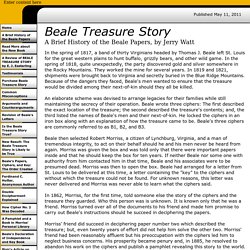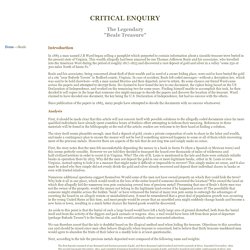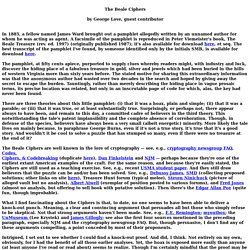

Beale Codes: Solving an Unsolvable Code? - DAVID MEYER. Between 1819 and 1821, Thomas Beale buried a giant treasure in Virginia.

It has never been found. The key to its location lies in one of the most mysterious codes in history…the Beale Codes. But how does one go about solving an unsolvable cipher? The Mysterious Beale Treasure? Last Friday, I posted the first story in a short series about the mysterious Beale Treasure. “The Beale Ciphers were three codes which would enable one to locate the treasure and distribute it to the rightful heirs in the event that the group didn’t survive.
Only one of the Beale Codes – the second one – has ever been decoded. Solving Beale Code #2? Beale Code #2 is a book code. This code was supposedly solved by a “friend” of Robert Morriss. Solving the Unsolvable Ciphers? Assuming the Beale Codes are real, it stands to reason the remaining ciphers are encoded like Beale Code #2. The second approach is to employ computers in a brute force attack. Guerrilla Explorer’s Analysis. The Beale Papers - Original Text. The following is a reprint of "The Beale Papers" published in 1885 by J.

B. Ward. They supposedly lead to a fortune buried in the Virginia hills that has never been recovered. For the full story, check the Museum's Beale Cryptograms Page. The Beale Papers containing Authentic Statements regarding the TREASURE BURIED in 1819 and 1821, near Bufords, in Bedford County, Virginia, and Which Has Never Been Recovered. Lynchburg: Virginian Book and Job Print 1885. Entered according to act of Congress, in the year 1885, by J. The following details of an incident that happened many years ago, but which has lost none of its interest on that account, are now given to the public for the first time. Until the writer lost all hope of ultimate success, he toiled faithfully at his work; unlike any other pursuit with practical and natural results, a charm attended it, independent of the ultimate benefit he expected, and the possibility of success lent an interest and excitement to the work not to be resisted.
A Brief History of the Beale Papers. A Brief History of the Beale Papers, by Jerry Watt In the spring of 1817, a band of thirty Virginians headed by Thomas J.

Beale left St. Louis for the great western plains to hunt buffalo, grizzly bears, and other wild game. In the spring of 1818, quite unexpectedly, the party discovered gold and silver somewhere in the Rocky Mountains. They worked the mine for several years. An elaborate scheme was devised to arrange legacies for their families while still maintaining the secrecy of their operation. Beale then selected Robert Morriss, a citizen of Lynchburg, Virginia, and a man of tremendous integrity, to act on their behalf should he and his men never be heard from again.
BEALE TREASURE STORY: Virginia treasureStory. Beale Treasure. Introduction In 1885 a man named J.B Ward began selling a pamphlet which purported to contain information about a sizeable treasure trove buried in the present state of Virginia.

This wealth allegedly had been amassed by one Thomas Jefferson Beale and his associates, who travelled into the American West during the period of roughly 1817-1823 and discovered a vast deposit of gold and silver in a valley "some 250 or 300 miles North of Santa Fe. " Beale and his associates, being concerned about theft of their wealth and in need of a secure hiding place, were said to have buried the gold at a site "near Bufords Tavern" in Bedford county, Virginia. In case of accident, Beale left coded messages—without a decryption key, which was said to be held elsewhere—with a man named Morriss and then departed, never to return.
By some chance our friend Ward came across the papers and attempted to decrypt them. Analysis This is an appreciable amount of material. The Beale Ciphers by George Love. [Aside: It's amusing to note that using the pamphlet Declaration introduces a typo not generally found in the Beale literature.

The "u" in "four" is indicated by code 95, which in the standard Declaration is correct. The pamphlet, though, has inalienable. I infer that the typesetter introduced this "error" -- which hearkens back to a classic Jefferson-Adams debate over which word to use - since the pamphlet's decrypted message has "u".] [Aside 2: How did the pamphlet author know 1005 was supposed to be "x"? How did he know the corrections for the other five mistakenly-selected codes? [Aside 3: Arguably, for the reason noted in the preceding paragraph, my analysis perhaps should have first extracted the clear text, then resolved the typos and ended with the overlay of miscounts.
To circle up, what this analysis shows is that, due to six separate counting errors, more than 130 code references in Cipher No. 2 are wrong when compared to a true word count of the Declaration. Sarasota Herald-Tribune - Google News Archive Search. Beale Treasure.